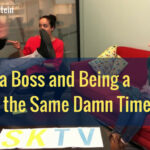The team had nicknamed their boss “Lunch Box” so they could talk trash about him in the company chat room without him noticing. As if that’s not sad enough, what’s even sadder is that Lunch Box didn’t even know his team had nicknamed him Lunch Box. Sometimes he’d jump in on the conversations, thinking they were actually talking about a lunch box! I wish I could say this was a fake story, but this really did happen. Despite loads of funding and a team of 30 employees, the company didn’t last and eventually shut down.
At some point, bad company culture will catch up to you, so it’s best to improve company culture sooner rather than later. Unless everyone is on board with how things are done in your organization, the danger is bound to be ahead.
To help you avoid the danger ahead, here are three signs your company culture might be in trouble:
1) Owner-Coach-Player Gap
In prior posts, I’ve referenced the Owner-Coach-Player dynamic that exists on any team. Each character wears a different hat and is often responsible for different metrics. The division of labor and responsibility is healthy for a team, but the further that division is, the more dangerous it becomes. If the owner doesn’t have a clear understanding of her front-line workers’ operation on a daily basis, then any high-level strategic change might send negative ripples down the line.
To avoid an Owner-Coach-Player gap, make sure there are communication channels in place that drive important information quickly up and down the line. Also, as a leader, figure out ways to occasionally put yourself “on the floor” with your frontline workers. That way, you’ll not only get a first-hand experience of what it’s like, you’ll also build a relationship with your players.
2) Lack of Ownership
Ever hear the joke about how three guys walked into a bar… and they all got hurt because no one from the construction site moved the bar? Moving the bar wasn’t one person’s specific responsibility, but in an ownership driven culture, someone would’ve realized the bar needed to be moved. Instead of waiting for someone else to tell them to move it, they would do so on their own because they would know it needed to be done. If you are struggling with your team members only doing what they are told or is part of their job description, your culture might be in danger.
To turn things around, start rewarding those who are stepping up, so others see the value in doing more. Also, have one-on-one conversations with each team member to find out their intrinsic motivators. Find out what most excites them about the job, and see if you can align some responsibilities (not just more tasks) for them to be in charge of.
3) Unbalanced Social Time
The Swift Kick team used to share an office table with another company in our co-working space in NYC. However, the two groups of people naturally wanted to talk with each other about every possible topic. Some conversations were short, but others would extend for 20 minutes. After a few rounds of social conversation, the two teams decided it was better if we didn’t sit at the same table so that we could all focus more on work. Since then, we continue to be friends with the other company, but our social time at work isn’t over-powering our work time.
The phrase you know is, “Work hard, play hard.” The phrase is not, “Work a little bit, and socialize the rest of the time.” I want my team to love working at Swift Kick. I want them to love the work they do as well as each other and the office environment. While I may be flexible on work hours and social time, what I’m not flexible on are outcomes and metrics. Check your team to see how balanced their work time is versus their social time, and if things are out of whack.
*The Lunch Box story is a cautionary case study in waiting too long to realize that your team culture is bad. Culture takes time to build up, so don’t wait until it’s too late to work on it. Changing the company culture often starts at the top and with buy-in from everyone until it is instilled system-wide. Don’t wait, look around today and catch the smoke before it turns into fire.




